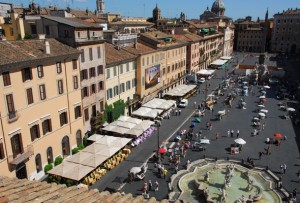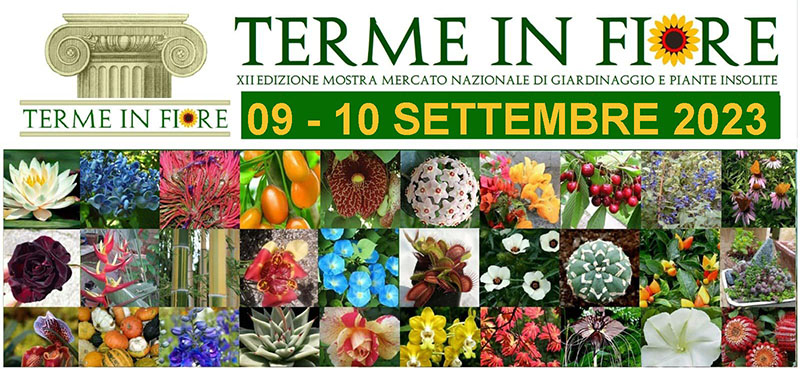










Rome in Two Days
 Only two days to visit Rome? Here follows an exciting itinerary for visitors with only a short time to discover the city’s main attractions.
Only two days to visit Rome? Here follows an exciting itinerary for visitors with only a short time to discover the city’s main attractions.
First DayRoute:
Basilica of St. Peter in the Vatican – Castel S. Angelo -Piazza Navona – Pantheon – Piazza di Spagna
The Vatican City
As soon as you arrive in Piazza San Pietro, the visitor is first struck by the grandeur of the square spreading out before the Basilica of St. Peter, framed by the magnificent four column-deep colonnade designed by Gian Lorenzo Bernini. However it is only on entering the Basilica itself, after climbing the three tiered set of steps (once again designed by Bernini), is one truly over-awed by the vast size and sumptuousness of this symbol of Christianity. The largest church in the world’s surface covers around 22,00 square metres; its Michelangelo designed dome is 42 metres wide; the entire building rises to a height of 136 metres, while 330 steps take you to the top of the dome for an exquisite panorama of the square and Rome. Countless masterpieces of major artists are be found inside: Bernini’s majestic 29 metre high bronze baldacchino; Michelangelo’s superb sculpture the Pietà; Canova’s tomb for Pope Clement XIII and Giotto’s restored mosaic The Navicella which is in a lunette over the central opening into the portico. Innumerable and timeless works, the majority of which are paintings, are also waiting to be admired in the Vatican Museums. Of inimitable beauty, here is also housed one of the cornerstones of Italian and indeed world art, Michelangelo’s Sistine Chapel.
Castel Sant’Angelo
The second stop on our itinerary is just a short walk down Via della Concilliazione. With its National Museum bearing its name, Castel Sant’Angelo, as well as boasting the marvellous stuccos, frescos and furnishing of its papal apartments, is also home to an important collection of ancient weapons. Castel Sant’Angelo moreover gained automatic fame on the premiere of Giacomo Puccini’s Opera Tosca at the Teatro Costanzi in Rome on 14th January 1900. The opera in fact ends in tragedy with the main character, Tosca, hurling herself to her death over the castle’s ramparts.
Piazza Navona
Piazza Navona is reached by crossing the Tiber at Ponte Sant’Angelo and veering to the left. Viewed from above, the square’s outline is that of an arena. It was in fact built on top of Domitian’s Stadium, the remains of which are to be found in the piazza’s Seventeenth Century Baroque Church of Sant’Agnese in Agone, which was designed by that great architect Francesco Borromini. Adorning the piazzaare its three sumptuous fountains: the Fountain of the Moor, the Fountain of Neptune and the most important of all, Bernini’s Fountain of the Four Rivers (the Nile, Ganges, Danube and Rio de la Plata). During the festive season from early December to the Epiphany, the piazza is annually filled with Christmas stalls selling toys, sweets and crib figures.
Over an amphitheatre dating from Emperor Nero’s rule, Domitian had a stadium built towards 86 A.D. However over the course of the centuries, Piazza Navona was the favourite spot to hold games, tournaments and processions. Between the seventeenth and nineteen centuries, the piazza was often flooded for aquatic games and to stage naval battles, where boats of princes and prelates would be paraded with the letting off of fireworks.
Pantheon
The pantheon is nothing less than the finest example of the very best architectonic craft of ancient Rome. The simple harmonious structure results from its perfect cylindrical proportions, given that the diameter of the dome is equal to the height of the building. Its interior provides the last resting for a number of important personages. Here lies the tomb of High Renaissance Painter and Architect Raphael, Baroque Painter Annibale Carracci and the Kings Vittorio Emanuele II and Umberto I. Dominating the square outside is G. Della Porta’s delightful Renaissance fountain surmounted by Rameses’ II’s obelisk.
Piazza di Spagna
Renowned world over for its spectacular steps, designed by Francesco De Sanctis between 1723 and ’26, as well as for Pietro Bernini and his son Gian Lorenzo’s 1629 half-sunk boat-shaped fountain called “La Barcaccia”, Piazza di Spagna is an important meeting point for both Romans and tourists. Rising up on top of the Steps and overlooking the Piazza is the Church of Trinità dei Monti, which was built on the wishes of King Louis XII of France in 1502. Shifting our gaze to the left, Villa Medici sul Pincio, today the seat of the French Academy, comes into sight. Fanning out from the piazza below are a myriad of streets where both the top fashion brands are to be found as well as sites of historical and cultural interest. Not to be missed is the Café Greco in Via dei Condotti.
Second Day
Itinerary:
Colosseum – Via dei Fori Imperiali – Roman Forum – Campidoglio (Capitol Hill) and the Capitoline Museums
Colosseum
Its name actually derived from a nearby over 35 metre high colossal bronze statute of the Emperor Nero. Symbol of Rome worldwide, the Colosseum was built by emperors of the Flavian dynasty between 72 and 80 A.D. on the site already occupied by an artificial lake which was part of the huge Domus Aurea (a compound of buildings and gardens built by Nero of which just the decorated ruins that inspired Renaissance artists remain). 100,000 square metres of travertine from the quarries in Tivoli were used for this amphitheatre, the largest every built in the Roman empire. A capacity crowd of 75,000 was entertained to contests between gladiators, animal hunts, executions, etc. The arena was also flooded to become an artificial lake in order stage mock sea battles. The architect who designed the Colosseum “as a reward for his work” is said to have been thrown alive to the wild beasts, inaugurating in a way the long tradition that was to follow of cruelty and bloodshedding in the very building he had conceived. In the Medieval era, it was turned into a fortress, then into a make-shift quarry to be stripped of material to build housing, workshops, quarters for a religious order, hospitals. The pillaging was only put to an end when Pope Benedict XIV declared the Colosseum a sacred site.
The Forums
The Roman Forum is Rome’s most important archaeological site, stretching from Campidoglio to the Palatine. As early as in VII A.D. this area was already teeming with religious, business and political activity. Added to Roman Forum were at later dates the Imperial Forums: the Forum of Julius Caesar, of Augustus, of Nerva, Vespasian, and the domineering Trajan Forum, whose Column and Markets are today still standing, unfailingly attracting the admiration of visitors worldwide.
Campidoglio (Capitol Hill)
Right from the early beginnings of Rome its famous hill was the site of the ruling authorities and theatre for official public celebrations. Michelangelo’s stunning piazza is flanked by three buildings: Palazzo Senatorio, which serves as the seat of the Mayor of Rome, stands in the centre; while on each side are the identical Palazzo dei Conservatori and Palazzo Nuovo, home to the Capitoline Museum. More than 200 paintings from the fourteenth to eighteenth centuries are on display in The “Musei Capitolini’s” Pinacoteca (Art Gallery), including those by such celebrated artists as Titian, Pietro da Cortona, Caravaggio, Guercino, Rubens, and many others. Justifiably taking centre stage in the piazza itself is a replica of the bronze statue of the Roman Emperor Marcus Aurelius, which escaped the usual fate of being melted down for reuse for coins or to make into another statue, because it was erroneously believed to depict the first Christian Emperor Constantine. While its pedestal was made by Michelangelo, the original statue is to be found in the nearby museum. A pathway, which has only recently been opened to the public, connects Piazza del Campidoglio to the terrace of the imposing Vittoriano Monument (Altar of the Fatherland) from where a simply breathtaking view of the whole city may be enjoyed. Admission is free to all of the Vittoriano, Monument to Italy’s first king, Vittorio Emanuele II, which also houses the Sacrario delle Bandiere (Museum of Flags) and Museum of the Risorgimento. The monument was opened in 1911 marking the 50th anniversary of the Unification of Italy and since 1921 holds the Tomb of the Unknown Soldier.







